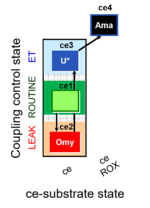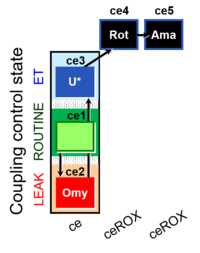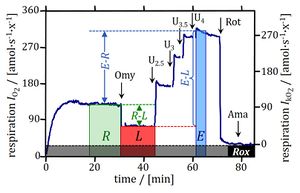Difference between revisions of "SUIT-003 O2 ce D009"
From Bioblast
| Line 6: | Line 6: | ||
|SUIT number=D009_ce1;ce2Omy;ce3U;ce4Rot;ce5Ama | |SUIT number=D009_ce1;ce2Omy;ce3U;ce4Rot;ce5Ama | ||
}} | }} | ||
::: '''[[MitoPedia: SUIT]]''' - Coupling control protocol (CCP) in living cells (ce) with oligomycin (LEAK state) | ::: '''[[MitoPedia: SUIT]]''' - [[Coupling control protocol]] (CCP) in living cells (ce) with oligomycin (LEAK state) | ||
::: '''[[SUIT protocol pattern]]:''' | ::: '''[[SUIT protocol pattern]]:''' ce1;ce2Omy;ce3U | ||
CCP-ce (SUIT-003 O2 ce D009) is designed to study [[coupling control state |coupling control]] of living cells. Respiratory capacities are tested in a sequence of coupling states: [[ROUTINE]], [[LEAK]] and [[ET]]. To study [[LEAK-respiration]], the [[phosphorylation system]] is inhibited by [[oligomycin]]. The final concentration of [[oligomycin]] has to be carefully optimized for various cell types, to minimize the inhibitory effect on the [[Electron transfer-pathway|electron transfer system]] which would lead to an underestimation of [[ET-capacity]]. | |||
SUIT-003 O2 ce D009 | |||
__TOC__ | __TOC__ | ||
Communicated by [[Iglesias-Gonzalez J]], [[Krumschnabel G]], [[Doerrier C]], [[Cardoso LH]] | Communicated by [[Iglesias-Gonzalez J]], [[Krumschnabel G]], [[Doerrier C]], [[Cardoso LH]], [[Gnaiger E]] (last update 2019-06-06) | ||
{{Template:SUIT-003 O2 ce D009}} | {{Template:SUIT-003 O2 ce D009}} | ||
== Strengths and limitations == | == Strengths and limitations == | ||
:::* The | :::* The CCP-ce (SUIT-003 O2 ce D009) is a [[coupling control protocol]] for living cells. In a living cell population, the total cell count (''N''<sub>ce</sub>) is the sum of viable cells (''N''<sub>vce</sub>) and dead cells (''N''<sub>dce</sub>). | ||
:::* This protocol can be extended with the cell viability test module (See CCV [[SUIT-003 O2 ce-pce D020]]) | :::* This protocol can be extended with the cell viability test module (See CCV [[SUIT-003 O2 ce-pce D020]]) | ||
:::* CIV activity can also be measured after the cell viability test module. | :::* CIV activity can also be measured after the cell viability test module. | ||
Revision as of 08:21, 6 June 2019
Description
Abbreviation: CCP-ce
Reference: A: - SUIT-003
SUIT number: D009_ce1;ce2Omy;ce3U;ce4Rot;ce5Ama
O2k-Application: O2
- MitoPedia: SUIT - Coupling control protocol (CCP) in living cells (ce) with oligomycin (LEAK state)
- SUIT protocol pattern: ce1;ce2Omy;ce3U
CCP-ce (SUIT-003 O2 ce D009) is designed to study coupling control of living cells. Respiratory capacities are tested in a sequence of coupling states: ROUTINE, LEAK and ET. To study LEAK-respiration, the phosphorylation system is inhibited by oligomycin. The final concentration of oligomycin has to be carefully optimized for various cell types, to minimize the inhibitory effect on the electron transfer system which would lead to an underestimation of ET-capacity.
Communicated by Iglesias-Gonzalez J, Krumschnabel G, Doerrier C, Cardoso LH, Gnaiger E (last update 2019-06-06)
Steps and respiratory states
| Step | State | Pathway | Q-junction | Comment - Events (E) and Marks (M) |
|---|---|---|---|---|
| ce1 | ROUTINE | ce1
| ||
| ce2Omy | LOmy | ce1;ce2Omy
| ||
| ce3U | E | ce1;ce2Omy;ce3U
| ||
| ce* | ROX | ce1;ce2Omy;ce3U;ce*
|
- Bioblast links: SUIT protocols - >>>>>>> - Click on [Expand] or [Collapse] - >>>>>>>
- Coupling control
- Pathway control
- Main fuel substrates
- » Glutamate, G
- » Glycerophosphate, Gp
- » Malate, M
- » Octanoylcarnitine, Oct
- » Pyruvate, P
- » Succinate, S
- Main fuel substrates
- Glossary
Strengths and limitations
- The CCP-ce (SUIT-003 O2 ce D009) is a coupling control protocol for living cells. In a living cell population, the total cell count (Nce) is the sum of viable cells (Nvce) and dead cells (Ndce).
- This protocol can be extended with the cell viability test module (See CCV SUIT-003 O2 ce-pce D020)
- CIV activity can also be measured after the cell viability test module.
- + Reasonable duration of the experiment.
- - The concentration of oligomycin has to be carefully tested to avoid inhibitory effects in the evaluation of the ET-capacity.
- - Careful washing is required after the experiment to avoid carry-over of inhibitors and uncoupler.
Compare SUIT protocols
- SUIT-003 O2 ce D012 for non-permeabilized cells with pyruvate and oligomycin
- SUIT-003 O2 ce D028 for cell membrane permeability test CCP(S)
- SUIT-003 O2 ce-pce D013 first version of the Coupling control protocol and respirometric cell viability test (CCV protocol)
- SUIT-003 O2 ce-pce D018 second version of the Coupling control protocol and respirometric cell viability test (CCV protocol)
- SUIT-003 Ce1;ce2P;ce3U;ce4Glc;ce5M;ce6Rot;ce7S;1Dig;1c;2Ama;3AsTm;4Azd coupling control protocol and respirometric cell viability test (CCV protocol) without oligomycin.
- SUIT-003 Ce1;ce2U-
- SUIT-003 Ce1;ce2SD;ce3Omy;ce4U-
- SUIT-003 Ce1;ce2SD;ce3U;ce4Rot;ce5Ama
- SUIT-003 Ce1;ce2U;ce3Rot;ce4S;ce5Ama
- SUIT-006: Coupling control protocol for mt-preparations, counterpart to SUIT-003 for non-permeabilized cells (ce).
References
| Year | Reference | Organism | Tissue;cell | |
|---|---|---|---|---|
| MiPNet08.09 CellRespiration | 2016-08-11 | High-resolution respirometry and coupling-control protocol with living cells: ROUTINE, LEAK, ET-pathway, ROX. | Human | Blood cells Lymphocyte |
| Gnaiger 2008 POS | 2008 | Gnaiger E (2008) Polarographic oxygen sensors, the oxygraph and high-resolution respirometry to assess mitochondrial function. In: Mitochondrial dysfunction in drug-induced toxicity (Dykens JA, Will Y, eds) John Wiley & Sons, Inc, Hoboken, NJ:327-52. | Mouse | Blood cells |
| Huetter 2004 Biochem J | 2004 | Hütter E, Renner K, Pfister G, Stöckl P, Jansen-Dürr P, Gnaiger E (2004) Senescence-associated changes in respiration and oxidative phosphorylation in primary human fibroblasts. https://doi.org/10.1042/BJ20040095 | Human | Fibroblast |
ce1;ce2Omy;ce3U;ce4Rot;ce5Ama
- ce1;ce2Omy;ce3U;ce4Rot;ce5Ama
- In this ceCCP, ROX is measured after stepwise titration of rotenone (ce4Rot) and antimycin A (ce5Ama). In many intact cells ROX measured after titration of rotenone (ce4Rot) is not or only slightly further inhibited by subsequent addition of antimycin A (ce5Ama).
- Respiration in senescent human primary fibroblasts (0.2×106 cells/ml). Arrows show steps in the titration regime of the coupling control protocol, inducing the following respiratory states.
- ce1: ROUTINE (R; routine state in cell-culture medium) in intact cells (ce);
- ce2Omy: LEAK (L; inhibition of ATP-synthase by 1 μg/ml oligomycin);
- ce3U: ET-state (E; maximal stimulation by uncoupling of oxidative phosphorylation in four subsequent titrations of the uncoupler, U, FCCP (2.5–4 μM final concentration);
- ce4Rot: ROX (rotenone, Rot; residual oxygen consumption).
- ce5Ama: ROX (antimycin A, Ama; residual oxygen consumption). Modified after Huetter_2004_Biochem J.
- Respiration in senescent human primary fibroblasts (0.2×106 cells/ml). Arrows show steps in the titration regime of the coupling control protocol, inducing the following respiratory states.
MitoPedia concepts:
SUIT protocol,
SUIT A,
Find
MitoPedia methods:
Respirometry





